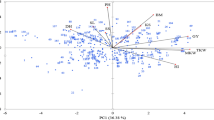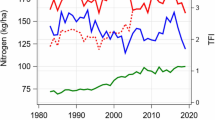Abstract
Development of gibberella ear rot (GER) resistant genotypes in maize is important to reduce yield loss and most importantly to avoid mycotoxin contamination of food and feed. The objective of the current study was to investigate the effect of kernel drydown rate (KDD) on GER disease development and to test whether using KDD as an indirect selection trait could warrant selection gains for GER resistance. Six inbred lines with various levels of disease resistance were evaluated for GER silk and kernel resistance and KDD as line per se and testcrosses in one location over three consecutive years. From our results, the genotypes showed significant differences (P < 0.05) to GER and KDD. Heritability estimates were high for GER and were consistently higher than estimates for KDD. Genotypic correlation estimates between GER and KDD, which were averaged over the 3 years were significant (P < 0.01, 0.05) only for kernel inoculated plots and the strength of correlations increased when kernels progress towards maturity. The indirect selection efficiency of KDD as compared to direct selection for GER was less than one but was substantially higher for kernel inoculated plots. Our overall result demonstrated that fast KDD was among the factors that contribute to kernel resistance to GER however its use as an indirect selection trait was less promising. Thus, screening for GER resistance using disease inoculated nurseries still remain to be the most effective method for GER breeding.



Similar content being viewed by others
References
Assabgui RA, Reid LM, Hamilton RI, Arnason JT (1993) Correlation of kernel (E)-ferulic acid content of maize with resistance to Fusarium graminearum. Phytopathology 83:949–953. doi:10.1094/Phyto-83-949
Atlin GN, Enerson PM, McGirr LG, Hunter RB (1983) Gibberella ear rot development and zearalenone and vomitoxin production as affected by maize genotype and Gibberella Zeae strain. Can J Plant Sci 63:847–853. doi:10.4141/cjps83-107
Bily AC, Reid LM, Taylor JH, Johnson D, Malouin C, Burt AJ, Bakan B, Regnault-Roger C, Pauls KP, Arnason JT, Philogène BJR (2003) Dehydrodimes of ferulic acid in maize grain pericarp and aleurone: resistance factors to Fusarium graminearum. Phytopathology 93:712–719. doi:10.1094/PHYTO.2003.93.6.712
Bolduan C, Miedaner T, Schipprack W, Dhillon BS, Melchinger AE (2009) Genetic variation for resistance to ear rots and mycotoxins contamination in early European maize inbred lines. Crop Sci 49:2019–2028. doi:10.2135/cropsci2008.12.0701
Cao A, Reid LM, Butron A, Malvar RA, Souto XC, Santiago R (2011) Role of hydroxycinnamic acids in the infection of maize silks by Fusarium graminearum Schwabe. MPMI 24:1020–1026. doi:10.1094/MPMI-03-11-0079
Chungu C, Mather DE, Reid LM, Hamilton RI (1996) Comparison of techniques for inoculating maize silk, kernel, and cob tissues with Fusarium graminearum. Plant Dis 80:81–84. doi:10.1094/PD-80-0081
Cooper M, Delacy IH, Basford KE (1996) Relationships among analytical methods used to analyze genotypic adaptation in multi-environment trials. In: Cooper M, Hammer GL (eds) Plant adaptation and crop improvement. CAB Int, Wallingford, pp 193–224
Crane PL, Miles SR, Newman JE (1959) Factors associated with varietal differences in rate of field drying in corn. Agron J 51:318–320. doi:10.2134/agronj1959.00021962005100060003x
Cross HZ (1985) A selection procedure for ear drying-rates in maize. Euphytica 34:409–418. doi:10.1007/BF00022936
Dwyer LM, Ma BL, Evenson L, Hamilton RI (1994) Maize physiological traits related to grain yield and harvest moisture in mid- to short-season environments. Crop Sci 34:985–992. doi:10.2135/cropsci1994.0011183X003400040029x
Falconer DS (1989) Introduction to quantitative genetics, 3rd edn. Longman, London
Gasura E, Setimela P, Edema R, Gibson PT, Okori P, Tarekegne A (2013) Exploiting grain-filling rate and effective grain-filling duration to improve grain yield of early-maturing maize. Crop Sci 53:2295–2303. doi:10.2135/cropsci2013.01.0032
Hallauer AR, Carena MJ, Miranda Filho JB (2010) Quantitative genetics in maize breeding, 3rd edn. Iowa State University Press, Ames
Löffler M, Kessel B, Ouzunova M, Miedaner T (2010) Population parameters for resistance to Fusarium graminearum and Fusarium verticillioides ear rot among large sets of early, mid-late and late maturing European maize (Zea mays L.) inbred lines. Theor Appl Genet 120:1053–1062. doi:10.1007/s00122-009-1233-9
Maresca M (2013) From the gut to the brain: journey and pathophysiological effects of the food-associated trichothecene mycotoxin deoxynivalenol. Toxins 5:784–820. doi:10.3390/toxins5040784
Martin M, Miedaner T, Dhillon BS, Ufermann U, Kessel B, Ouzunova M, Schipprack W, Melchinger AE (2011) Colocalization of QTL for gibberella ear rot resistance and low mycotoxin contamination in early European maize. Crop Sci 51:1935–1945. doi:10.2135/cropsci2010.11.0664
Mesterházy Á (1983) Relationship between resistance to stalk rot and ear rot of corn influenced by rind resistance, premature death and the rate of drying of the ear. Maydica 28:425–437
Miller JD, Miles M, Fielder DA (1997) Kernel concentrations of 4-acetylbenzoxazolin-2-one and diferuloylputrescine in maize genotypes and gibberella ear rot. J Agric Food Chem 45:4456–4459. doi:10.1021/jf970395e
Miller SS, Reid LM, Butler G, Winter SP, McGoldrick NJ (2003) Long chain alkanes in silk extracts of maize genotypes with varying resistance to Fusarium graminearum. J Agric Food Chem 51:6702–6708. doi:10.1021/jf0341363
Mode CJ, Robinson HF (1959) Pleiotropism and the genetic variance and covariance. Biometrics 15:518–537. doi:10.2307/2527650
Pestka JJ, Smolinski AT (2005) Deoxynivalenol: toxicology and potential effects on humans. J Toxicol Environ Health B 8:39–69. doi:10.1080/10937400590889458
Reid LM, Hamilton RI (1996) Effects of inoculation position, timing, macroconidial concentration, and irrigation on resistance of maize to Fusarium graminearum infection through kernels. Can J Plant Pathol 18:279–285. doi:10.1080/07060669609500625
Reid LM, Sinha RC (1998) Maize maturity and the development of gibberella ear rot symptoms and deoxynivalenol after inoculation. Eur J Plant Pathol 104:147–154. doi:10.1023/A:1008683701412
Reid LM, Bolton AT, Hamilton RI, Woldemariam T, Mather DE (1992a) Effect of silk age on resistance of maize to Fusarium graminearum. Can J Plant Pathol 14:293–298. doi:10.1080/07060669209500867
Reid LM, Mather DE, Hamilton RI, Bolton AT (1992b) Diallel analysis of resistance in maize to Fusarium graminearum infection via the silk. Can J Plant Sci 72:915–923. doi:10.4141/cjps92-115
Reid LM, Mather DE, Hamilton RI, Bolton AT (1992c) Genotypic differences in the resistance of maize silk to Fusarium graminearum. Can J Plant Pathol 14:211–214. doi:10.1080/07060669209500877
Reid LM, Spaner S, Mather DE, Bolton AT, Hamilton RI (1993) Resistance of maize hybrids and inbreds following silk inoculation with three isolates of Fusarium graminearum. Plant Dis 77:1248–1251. doi:10.1094/PD-77-1248
Reid LM, Nicol RW, Ouellet T, Savard M, Miller JD, Young JC, Stewart DW, Schaafsma AW (1999) Interaction of Fusarium graminearum and F. moniliforme in maize ears: disease progress, fungal biomass, and mycotoxin accumulation. Phytopathology 89:1028–1037. doi:10.1094/PHYTO.1999.89.11.1028
Reid LM, Woldemariam T, Zhu X, Stewart DW, Schaafsma AW (2002a) Effect of inoculation time and point of entry on disease severity in Fusarium graminearum, Fusarium Verticillioides, or Fusarium subglutinans inoculated maize ears. Can J Plant Pathol 24:162–167. doi:10.1080/07060660309506991
Reid LM, McDiarmid G, Parker AJ, Woldemariam T (2002b) CO441 corn inbred line. Can J Plant Sci 83:79–80. doi:10.4141/P02-058
Reid LM, Zhu X, Parker A, Yan W (2009) Increased resistance to Ustilago zeae and Fusarium verticilliodes in maize inbred lines bred for Fusarium graminearum resistance. Euphytica 165:567–578. doi:10.1007/s10681-008-9782-6
Reid LM, Zhu X, Morrison MJ, Woldemariam T, Voloaca C, Wu J, Xiang K (2010) A non-destructive method for measuring maize kernel moisture in a breeding program. Maydica 55:163–171
Reid LM, Zhu X, Wu J, Woldemariam T, Voloaca C, Morrison MJ, Xiang K (2014) Selecting maize for rapid kernel drydown: timing of moisture measurement. Maydica 59:9–15
Sabrova P, Adam V, Vasatikova A, Beklova M, Zeman L, Kizek R (2010) Deoxynivalenol and its toxicity. Interdisc Toxicol 3:94–99. doi:10.2478/v10102-010-0019-x
Searle SR (1965) The value of indirect selection: I. Mass selection. Biometrics 21:682–707. doi:10.1007/BF00274817
Stewart DW, Reid LM, Nicol RW, Schaafsma AW (2002) A mathematical simulation of growth of Fusarium in maize ears after artificial inoculation. Phytopathology 92:534–541. doi:10.1094/PHYTO.2002.92.5.534
Tollenaar M, Daynard TB, Hunter RB (1979) Effect of temperature on rate of leaf appearance and flowering date in maize. Crop Sci 19:363–366. doi:10.2135/cropsci1979.0011183X001900030022x
Troyer AF, Ambrose WB (1971) Plant characteristics affecting field drying rate of ear corn. Crop Sci 11:529–531. doi:10.2135/cropsci1971.0011183X001100040019x
Vigier B, Reid LM, Seifert KA, Stewart DW, Hamilton RI (1997) Distribution and prediction of Fusarium species associated with maize ear rot in Ontario. Can J Plant Pathol 19:60–65. doi:10.1080/07060669709500574
Vigier B, Reid LM, Dwyer LM, Stewart DW, Sinha RC, Arnason JT, Butler G (2001) Maize resistance to gibberella ear rot: symptoms, deoxynivalenol, and yield. Can J Plant Pathol 23:99–105. doi:10.1080/07060660109506915
Wu F (2007) Measuring the economic impacts of Fusarium toxins in animal feeds. Anim Feed Sci Technol 137:363–374. doi:10.1016/j.anifeedsci.2007.06.010
Yang J, Carena MJ, Uphaus J (2010) Area under the dry down curve (AUDDC): a method to evaluate rate of dry down in maize. Crop Sci 50:2347–2354. doi:10.2135/cropsci2010.02.0098
Acknowledgments
Funding for this project was in part provided by an AAFC partnership with the Canadian Field Crop Research Alliance (CFCRA) through AAFC’s Developing Innovative Agri-Products Initiative of the Growing Canadian Agri-Innovations Program. We thank anonymous reviewers for their helpful comments and suggestions to improve this manuscript.
Author information
Authors and Affiliations
Corresponding author
Rights and permissions
About this article
Cite this article
Kebebe, A.Z., Reid, L.M., Zhu, X. et al. Relationship between kernel drydown rate and resistance to gibberella ear rot in maize. Euphytica 201, 79–88 (2015). https://doi.org/10.1007/s10681-014-1185-2
Received:
Accepted:
Published:
Issue Date:
DOI: https://doi.org/10.1007/s10681-014-1185-2




